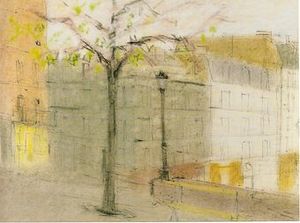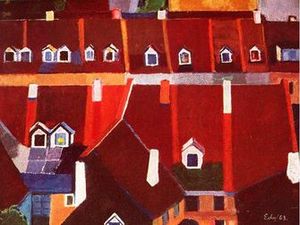Edo Kovačević facts for kids
Quick facts for kids
Edo Kovačević
|
|
|---|---|
| Born | 16 November 1906 Gospić, Austria-Hungary, today's Croatia
|
| Died | 15 March 1993 (aged 86) |
| Nationality | Croatian |
| Education | Zagreb, Paris |
| Known for | landscape art, set design |
|
Notable work
|
Zagreb Roofs series |
Edo Kovačević (born November 16, 1906 – died March 15, 1993) was a famous Croatian artist. He was known for his bright landscapes and scenes of Zagreb's suburbs. He mostly used oil paints and pastels. He created beautiful art by using soft colors and energetic brush strokes.
Kovačević also designed amazing stage sets for theaters for many years. These included the Croatian National Theatre and the Puppet Theatre. He taught art at the Zagreb School of Crafts. He also helped organize many art shows.
In the 1930s, Kovačević was part of an important art group called the Earth Group. Later, he showed his art with the Croatian Group of Artists. He became a member of the Croatian Academy of Sciences and Arts. In 1981, he won the Vladimir Nazor Award for his lifetime work in art.
Contents
Biography
Edo Kovačević was born on November 16, 1906, in Gospić. At that time, Gospić was part of Austria-Hungary, but today it is in Croatia. In 1909, his family moved to Zagreb.
In 1926, Kovačević started studying at the Academy of Fine Arts, Zagreb. He finished his studies in 1930. In 1928, he spent two weeks in Paris with other students. This trip opened his eyes to new ideas in art.
After graduating, Kovačević received a special grant. He spent a year (1930-1931) in Paris studying fresco painting. While there, he learned a lot about modern art. He was also inspired by famous painters like Giotto and Fra Angelico.
When he returned to Zagreb, Kovačević joined the Earth Group in 1932. This group believed art should show real-life problems. He was a member of this group until 1935.
From 1934 to 1940, he taught art at the Craft School in Zagreb.
Kovačević started designing stage sets in 1934 for the Croatian National Theatre. For almost 60 years, he created sets for many theaters. His work was seen in Zagreb, Dubrovnik, Ljubljana, and Prague. During this time, he also helped set up over a hundred art exhibitions.
Between 1936 and 1940, Kovačević showed his art with the Group of Croatian Artists. His work on exhibition setups allowed him to travel. He visited Paris many times and even went to the United States in 1939. After World War II, he traveled widely in Europe.
Kovačević had his first solo art show in 1955 in Zagreb. Later, big art galleries in Zagreb held shows of his work in 1964 and 1978.
In 1977, Edo Kovačević became a member of the Croatian Academy of Sciences and Arts. In 1981, he received the Vladimir Nazor Award. This award honored his amazing work in art throughout his life.
Edo Kovačević passed away in Zagreb on March 15, 1993.
His Art and Style
Edo Kovačević was a key artist in modern Croatian painting. His artworks showed a great sense of design and clear shapes. He was also a master of color. Art critics and the public loved his paintings.
His art teacher, Vladimir Becić, saw him as one of his most talented students. Kovačević quickly developed his own unique style. He was influenced by the Earth Group's ideas about showing real life.
Unlike other artists who painted big scenes of hard rural life, Kovačević focused on small details. These details told stories about simple ways of living. For example, his painting "Cornbread" (1930) shows a piece of cornbread, cheese, and a knife on a rough table. This simple scene shows the tough life of a farm worker.
Kovačević also painted many scenes of life in the suburbs. These paintings show how Zagreb grew and how people moved from the countryside. During his time with the Earth Group, his paintings had a flat, geometric look. But his use of color and his feeling for his subjects were all his own.
He used warm, soft colors and simple shapes to show homes, courtyards, roofs, streets, and factories. He showed these places without showing the faces of the people who lived there. By 1934, his painting "Kožarska ulica" showed a more refined use of color.
In the mid-1930s, Kovačević made drawings and gouaches of rural life. He started painting with more feeling. He used color to show nature in new ways. He also used more active brush strokes. Over the next few years, he used fewer colors and made his designs simpler.
During wartime, his paintings became more muted. They showed simple still lifes and portraits in single colors. The worries of war could be seen in his dramatic painting "Začretje Castle" (1941). This painting had a moody color palette and an orderly design. This style continued after the war.
By the late 1940s, Kovačević began to use specific colors to show the mood of his subjects. His "Self-Portrait" from 1948 used mostly soft blues. This coloring became a key part of his later work. Around this time, he also started painting landscapes of the Adriatic coast. These paintings had open spaces and bright, warm colors. They were more lively and used rich colors and geometric shapes.
Through the 1950s, Kovačević kept developing his unique soft color palette. His trips to Paris led to many drawings, pastels, and oil paintings. These works showed his personal feelings about the city. They used blue and brown tones. Art experts have called these balanced compositions masterpieces of Croatian art.
In the 1960s, Kovačević tried printing and lithography. In these works, his designs became very simple, almost abstract. He started using more symbols in his art, especially in flower paintings. This was also the time of his "Zagreb Roofs" series. In this series, Kovačević created rich, active patterns. These patterns were based on the old roofs seen from the upper part of Zagreb.
One of the best pieces from this series is the tapestry "Roofs" (1969). It wove together all his earlier ideas with a rich mix of colors. The "Roofs" series is one of his most important works. It shows his dedication to the city where he lived almost his whole life.
Edo Kovačević's later art was inspired by the landscapes around Zagreb. He captured nature in all its different weather and seasons. The woods near his house, called Zelengaj, appear in many of his beautiful works. He used oils or pastels to show different moods. He used subtle colors to show warm summer sun, soft spring rain, or thick winter fog.
During this time, he also painted flowers. He painted wild woodland flowers and summer meadow flowers in simple vases. Kovačević once said, "to paint flowers means to paint human joy, human nature, its unspoiled childish dream, its wonder at the world, its humanity. Aren't all these motifs that are worthy of painting?". Flowers allowed him to use his great composition skills and rich color combinations.
Edo Kovačević was an artist who liked to paint less obvious views. He often painted from unusual angles. He showed the backs and sides of buildings instead of the front. He gave us glimpses into humble courtyards or views across rooftops. He took simple subjects and used them to tell about human life. He also found joy in the beauty of nature. Most of all, he was a master of color. He used color to create shapes and feelings in his art.
Works
Paintings
- Cornbread, 1930
- Barutanski jarak (Barutan ditch), 1932
- Paper Factory, 1932
- Vineyards / Bukovački Breg, 1932
- Radnički dol
- Kožarska Ulica (Kožarska Street), 1934
- Začretje Castle, 1941
- Black Bottle, 1942
- Portrait of Mira, 1942
- Self-portrait, 1948
- Rovinj, 1948
- Yellow Houses in Bol, 1955
- Louvre, 1958
- Winter, 1964/65
- Signs (1966)
- Zagrebački krovovi (Zagreb roofs), 1964
- (Old Roofs – Duga ulica, 1962; Roofs – Mesnička ulica, 1966; Morning – Tkalčićeva ulica, 1963, and others).
- Zelengaj in Winter, 1970
- Snowman, 1970
- Rainy Spring, 1971
- Medvednica, 1972
- Zimska Radost (Winter happiness), 1973
- Mikulići - Springtide, 1975
- Šestine in Fog, 1975
- Klanječki vinogradi (Klanječki vineyards), 1981
Tapestry
- Roofs, 1969
Theatrical set designs
- Čudnovate zgode šegrta Hlapića (Marvellous Adventures of Hlapić the Apprentice), 1934
- Hofmanove priče (Tales of Hoffman), 1934
Exhibitions
Here are some recent solo exhibitions of Edo Kovačević's work:
Solo exhibitions
- 2006-2007 Edo Kovačević Retrospective, Art Pavilion, Zagreb
- 2003 Edo Kovačević - Dalmatian landscapes (graphics), Croatian Academy of Sciences and Arts
- 1997-8 Hommage Edo Kovačević 1906-1993 : Museum Gallery Klovićevi dvori, Zagreb
- 1993 Edo Kovačević - Landscapes Of Zagorje, Art Pavilion, Zagreb
- 1987 Edo Kovačević: Old Roofs of Zagreb, City Museum of Zagreb
- 1978 Edo Kovačić Retrospective, Art Pavilion, Zagreb
- 1964 Edo Kovačić Retrospective, Museum of Contemporary Art, Zagreb
Group exhibitions
These are some recent group exhibitions that included works by Edo Kovačević:
- 2010 Intimism in Croatian Fine Art 1930-1950, Modern Gallery, Zagreb
Public collections
Edo Kovačević's work can be found in these public collections:
- Museum of Contemporary Art, Zagreb
- Croatian Museum of Naive Art, Zagreb
- City Museum of Zagreb
- Gallery of Fine Arts, Osijek



